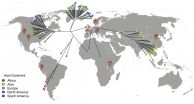(Press-News.org) August 13, 2015--A visit to the dentist has the potential to be more than a checkup of our teeth as patients are increasingly screened for medical conditions like heart disease and diabetes. A new study by researchers at Columbia University's Mailman School of Public Health focuses on dental screenings for drug misuse, finding 77 percent of dentists ask patients about illicit drug use, and 54 percent of dentists believe that such screenings should be their responsibility. Results of the study are online in the journal Addiction.
"There are a sizeable number of people whose visit to a dentist represents their sole interaction with the healthcare system, highlighting the significance of the dental visit as a key opportunity to identify substance use disorders," said Carrigan Parish, DMD, associate research scientist in the Department of Sociomedical Sciences. "However, our findings underscore a significant barrier in dentists' attitudes that may limit the potential of the dental venue to play a role in screening for substance misuse."
The researchers, led by Lisa Metsch, PhD, principal investigator and Stephen Smith Professor and chair of the Department of Sociomedical Sciences, sampled 1,802 U.S. dentists in general practice from a nationally representative survey by the American Dental Association Survey Center conducted from 2010 to 2011. The survey achieved a very high response rate of 71 percent, increasing the ability of the survey results to capture a complete picture of the U.S. dental workforce. According to Metsch, "there is an increasing recognition about the need to better integrate oral and systemic health," and "questions remain about the feasibility of offering preventive screening and testing alongside dental care--many of which are being answered in this study."
Those dentists who embraced substance misuse screening as part of their professional role were more likely to query about misuse with their patients (86 percent) compared with those who did not accept such screenings as their responsibility (68 percent). In general, both agreement with the purpose of and use of health history forms with substance misuse questions increased with the amount of prior training and knowledge regarding substance use.
Older dentists were less likely to report that their health history form included questions about substance misuse than those who were younger. Dentists under the median age of 53 were also more apt to say that illicit drug use screening should be part of the dentist's role than their more senior counterparts (62 percent versus 47 percent). As with age, agreement with screening as part of dentists' role and health history form screening increases markedly with how recently the dentist graduated.
Gender was also associated with dentists' attitudes toward screenings. More female dentists (61 percent) than their male counterparts (52 percent) agreed that illicit drug use screening should be the role of the dentist.
Drug use can have a negative impact on dental health as well as overall health. Patterns of oral health pathology attributed to methamphetamine users, for example, include rampant tooth decay, accelerated tooth wear, unexplained advanced gum disease, missing multiple teeth, and overall detrimental dental effects that are rapid and severe. These patients also often seek cosmetic dental treatment, such as veneers and whitening, which give dentists another opportunity to discuss suspected substance misuse, provide referrals for treatment, and encourage cessation of drug misuse.
Furthermore, dentists are the second-largest group of prescribers of opioid pain medication. "Because dental care routinely involves treating pain and emergencies, dentists may encounter substance-seeking patients who complain of pain more severe than anticipated based on the nature of their dental condition, who report lost prescriptions for opioid pain medications, or who only seek dental treatment sporadically," noted Parish.
"In order for substance misuse screening to be compatible with the dental setting, two-way communication between patient and dentist needs to occur more openly," observed Parish. "While surveys have shown that patients are amenable to receiving medical screenings by dentists 'chair-side' for such conditions as HIV, heart disease, and diabetes, further studies directly addressing patient attitudes on substance misuse screening are key in determining patients' acceptance of such services." Dentists may also need additional education to increase their awareness, comfort, and knowledge of substance misuse, given that "dentists are well situated to make appropriate referrals to treatment centers if instilled with the proper training and supports."
INFORMATION:
Funding was provided by the National Institute of Dental and Craniofacial Research (R01 DE019615). The authors declare no conflicts of interest.
About Columbia University's Mailman School of Public Health
Founded in 1922, Columbia University's Mailman School of Public Health pursues an agenda of research, education, and service to address the critical and complex public health issues affecting New Yorkers, the nation and the world. The Mailman School is the third largest recipient of NIH grants among schools of public health. Its over 450 multi-disciplinary faculty members work in more than 100 countries around the world, addressing such issues as preventing infectious and chronic diseases, environmental health, maternal and child health, health policy, climate change & health, and public health preparedness. It is a leader in public health education with over 1,300 graduate students from more than 40 nations pursuing a variety of master's and doctoral degree programs. The Mailman School is also home to numerous world-renowned research centers including ICAP (formerly the International Center for AIDS Care and Treatment Programs) and the Center for Infection and Immunity. For more information, please visit http://www.mailman.columbia.edu
TORONTO, (Aug. 13, 2015) - Low birth weight and preterm birth appear to increase the risk of schizophrenia among individuals with a genetic condition called the 22q11.2 deletion syndrome, a new study from the Centre for Addiction and Mental Health (CAMH) shows.
The research, published in Genetics in Medicine, is "...part of ongoing efforts among schizophrenia researchers to predict and prevent illness at the earliest stages possible," says senior author Dr. Anne Bassett, Clinician-Scientist in CAMH's Campbell Family Mental Health Research Institute and Canada Research ...
MANHATTAN, Kansas -- A Kansas State University biochemistry professor has reached a milestone in building a better biofuel: producing high levels of lipids with modified properties in oil seeds.
Timothy Durrett, assistant professor of biochemistry and molecular biophysics, and collaborators at Michigan State University and the University of Nebraska, Lincoln have modified Camelina sativa -- a nonfood oilseed crop -- and produced the highest levels of modified seed lipids to date. By modifying the oilseed biochemistry in camelina, the researchers have achieved very high ...
CLEMSON, S.C. -- Parishioners who participate in small groups within a religious congregation are generally more likely to be civically engaged than their fellow worshipers unless a church has high overall small-group participation, according to research recently released by Clemson and Louisiana State universities.
The study, "Small groups, contexts, and civic engagement: A multilevel analysis of United States Congregational Life Survey data," published in the July issue of the journal Social Science Research, reveals that the positive effect small-group participation ...
CORVALLIS, Ore. - A report concludes that blooms of toxic cyanobacteria, or blue-green algae, are a poorly monitored and underappreciated risk to recreational and drinking water quality in the United States, and may increasingly pose a global health threat.
Several factors are contributing to the concern. Temperatures and carbon dioxide levels have risen, many rivers have been dammed worldwide, and wastewater nutrients or agricultural fertilizers in various situations can cause problems in rivers, lakes and reservoirs.
No testing for cyanobacteria is mandated by state ...
SEATTLE, WA, AUGUST 13, 2015 - Advances in the field of statistics are helping to unlock the mysteries of the human microbiome--the vast collection of microorganisms living in and on the bodies of humans, said Katherine Pollard, a statistician and biome expert, during a session today at the 2015 Joint Statistical Meetings (JSM 2015) in Seattle.
Pollard, senior investigator at the Gladstone Institutes and professor of epidemiology and biostatistics at the University of California, San Francisco, delivered a presentation titled "Estimating Taxonomic and Functional Diversity ...
SEATTLE, WA, AUGUST 13, 2015 - The results of the first population survey of Mogadishu, Somalia, conducted in a quarter century were presented today at a session of the 2015 Joint Statistical Meetings (JSM 2015) in Seattle.
Jesse Driscoll, assistant professor of political science at the University of California, San Diego, presented the results in an invited presentation titled "Representative Surveys in Insecure Environments: A Case Study of Mogadishu, Somalia."
The representative survey, conducted in March 2012, combined the use of smartphone technology and remote-sensing ...
12.08.2015: When the western part of the super-continent Gondwana broke up around 130 Million years ago, today's Africa and South-America started to separate and the South Atlantic was born. It is commonly assumed that enormous masses of magma ascended from the deep mantle up to higher levels, and that this hot mantle plume (the Tristan mantle plume) weakened the continental lithosphere, eventually causing the break-up of the continental plate of Gondwana.
A group of German scientists are now questioning this theory. On the basis of seismic measurements published in ...
This news release is available in German.
Kalmar/Halle(Saale). Why some species of plants and animals vary more in number than others is a central issue in ecology. Now researchers at Linnaeus University in Sweden and from the Helmholtz Centre for Environmental Research (UFZ) have found an important finding to answer this question: Individual differences have a positive and stabilizing effect on the number of moths. Species with varying colour drawing are generally more numerous and fluctuate less in number from year to year. The results were recently published ...
Stillbirths have dropped by almost eight per cent in England since the smoking ban was introduced, research shows.
The number of babies dying shortly after birth has also dropped by almost eight per cent, the study estimates.
The findings add to growing evidence that anti-smoking laws have had significant benefits for infant and child health.
Researchers led by the University of Edinburgh looked at information on more than ten million births in England between 1995 and 2011.
Their findings suggest that almost 1500 stillbirths and newborn deaths were averted in ...
The team of Prof. Carsten Schmidt-Weber and Prof. Jan Gutermuth of the Center of Allergy & Environment (ZAUM) at Helmholtz Zentrum München and TU München investigated the influence of pollen extract of common ragweed, also known as Ambrosia artemisiifolia*, on B cells. These cells can produce immunoglobulin E (IgE**), the key trigger and an important diagnostic marker of allergic reactions. "We were able to show that pollen extract enhances the secretion of allergy driving IgE antibodies in vitro and in vivo", explains Dr. Sebastian Öder who is leading author ...


